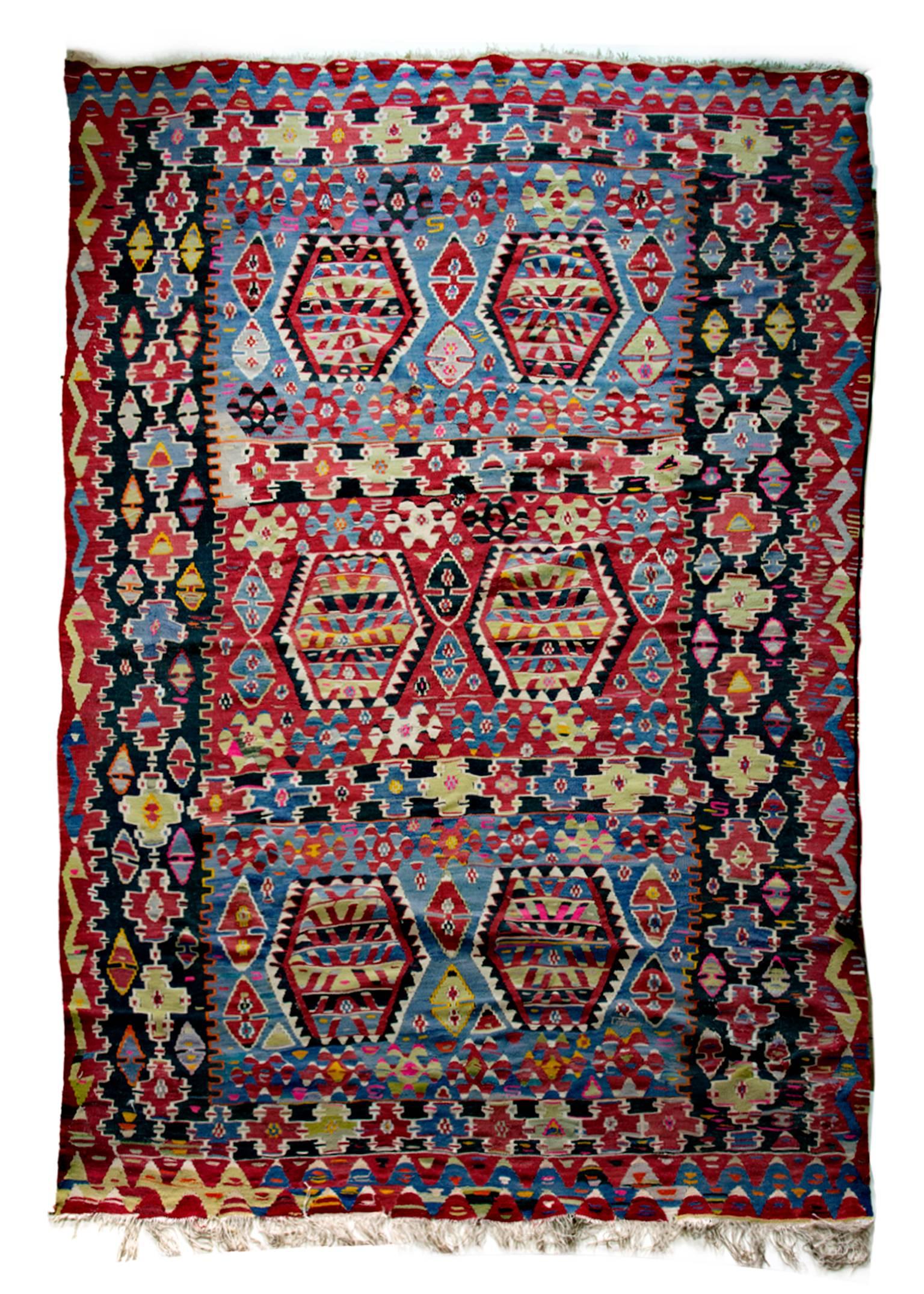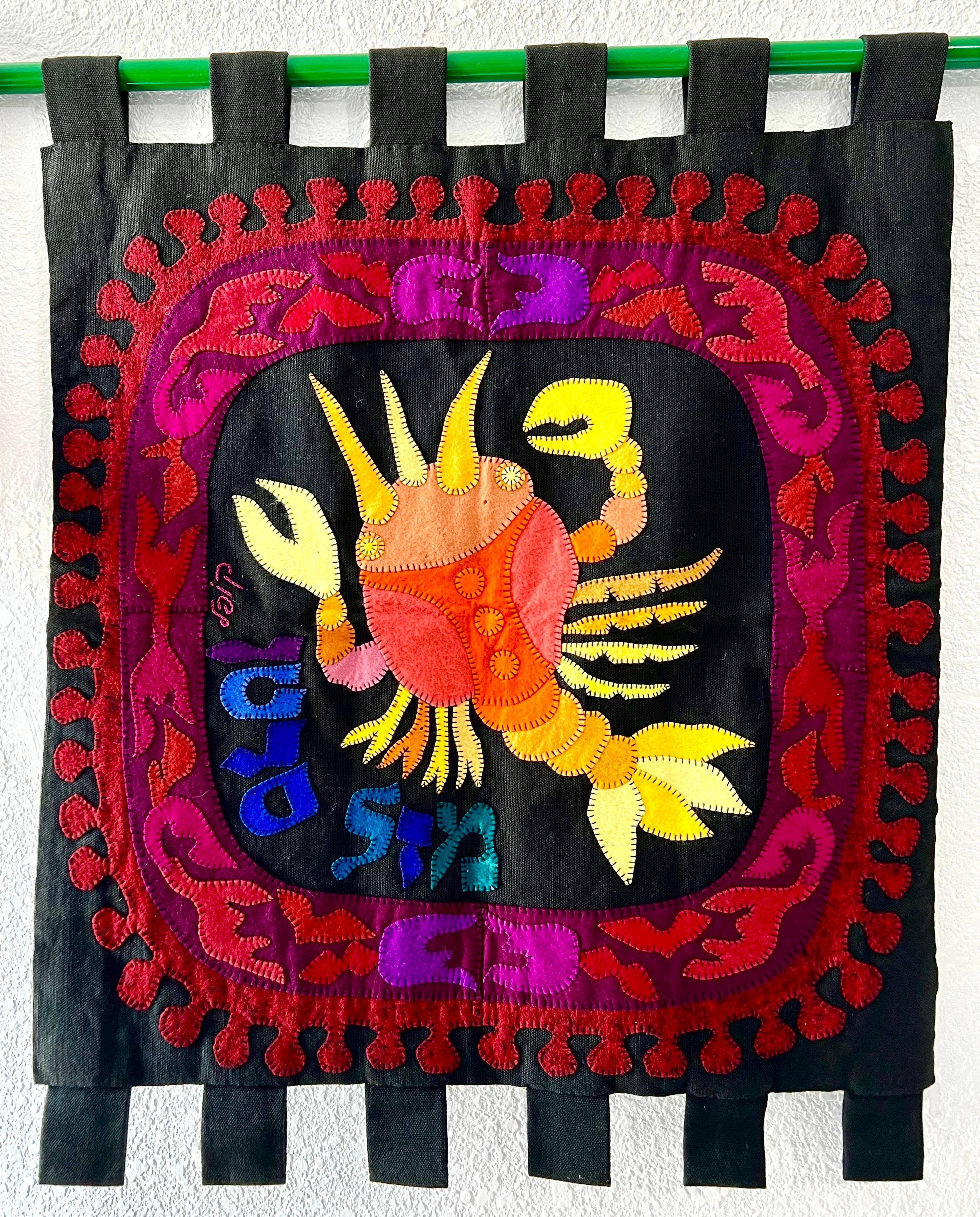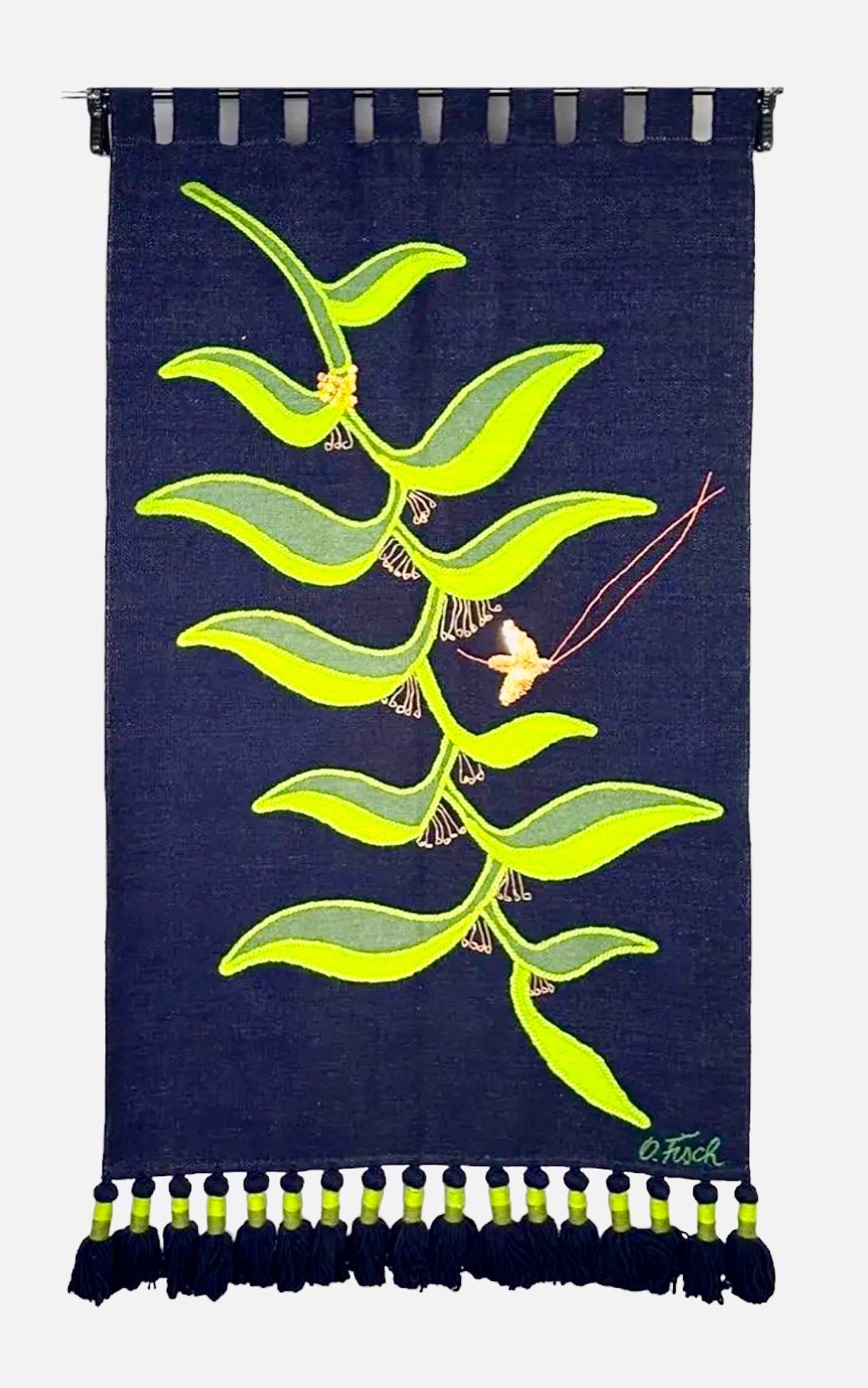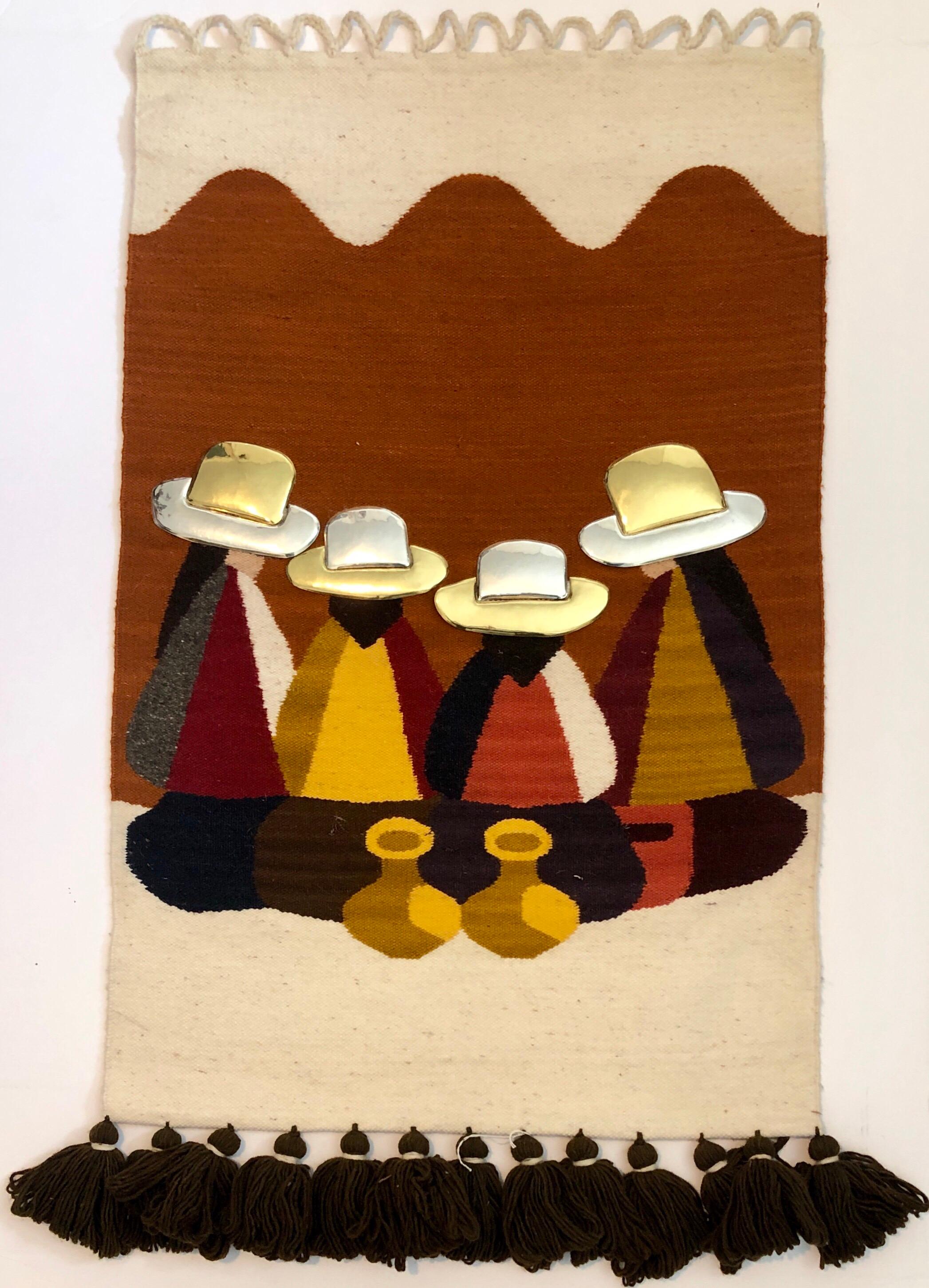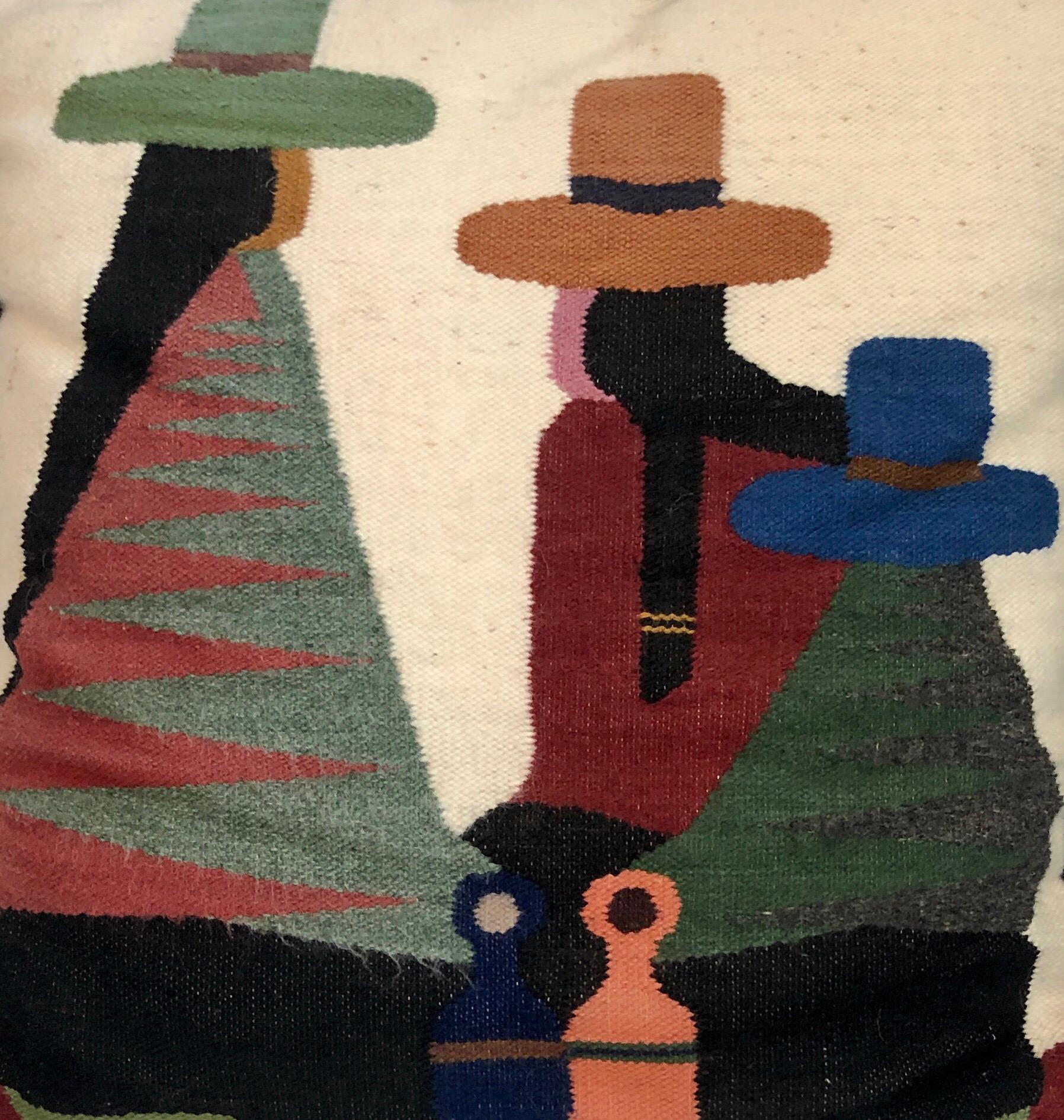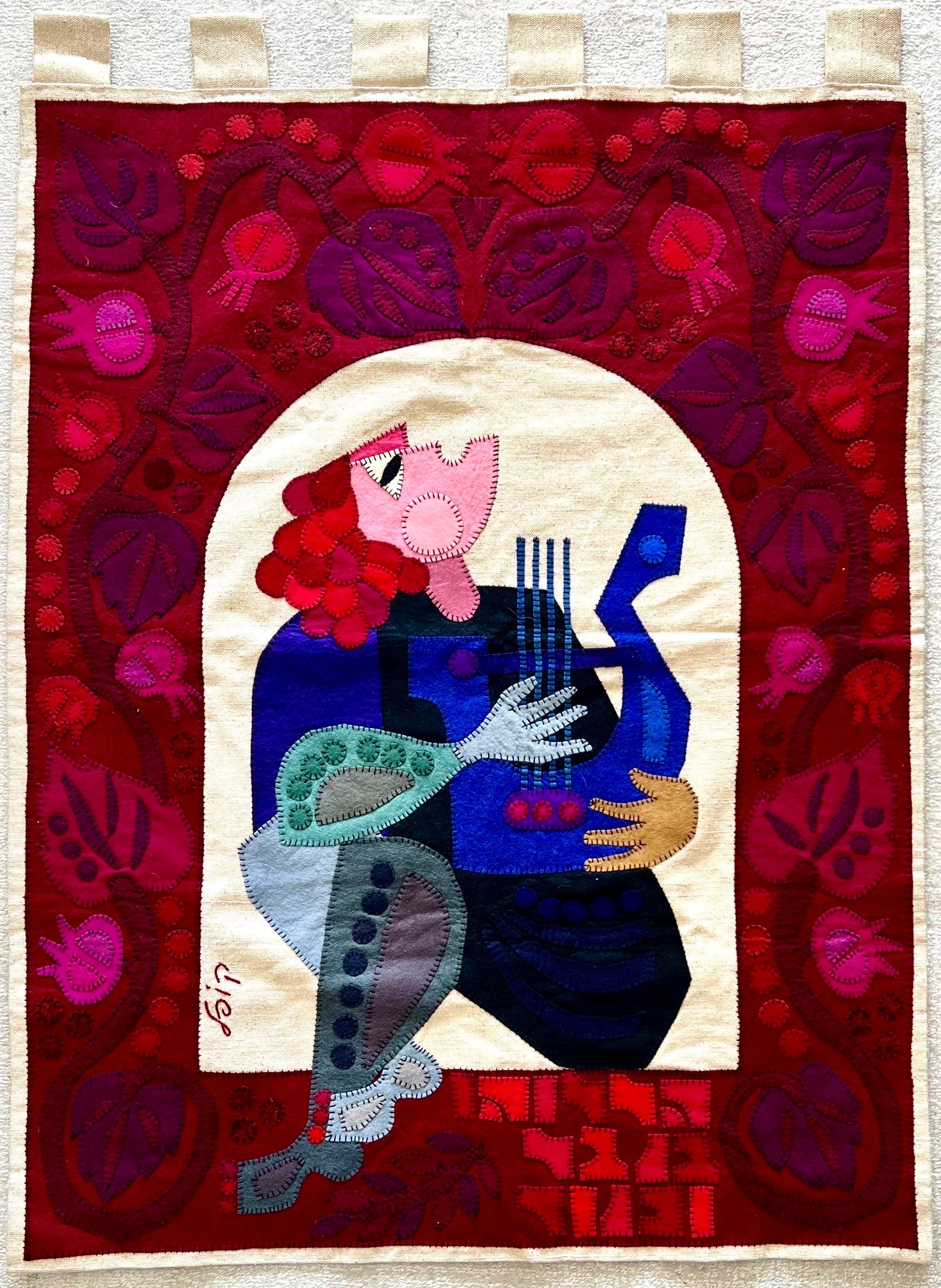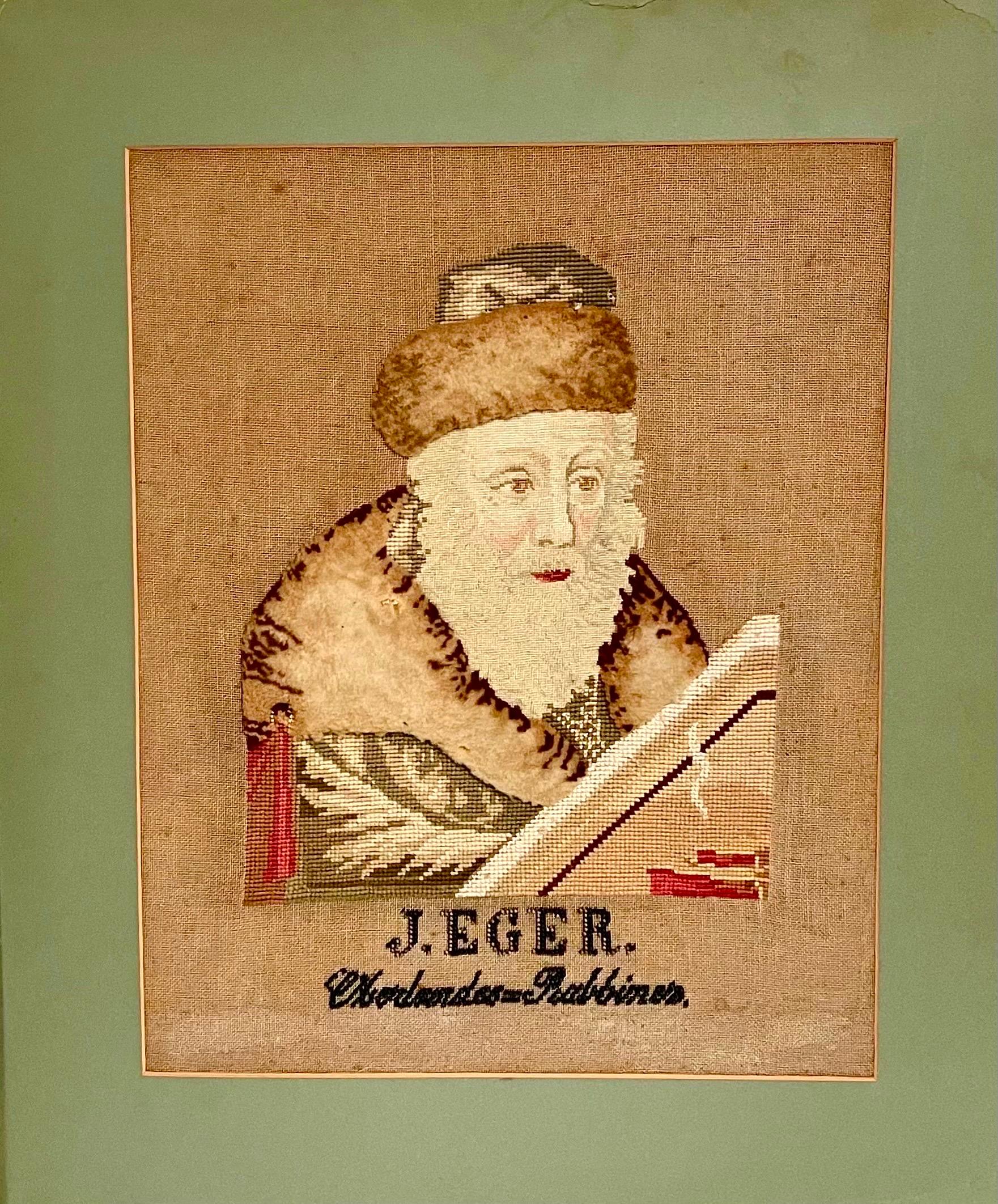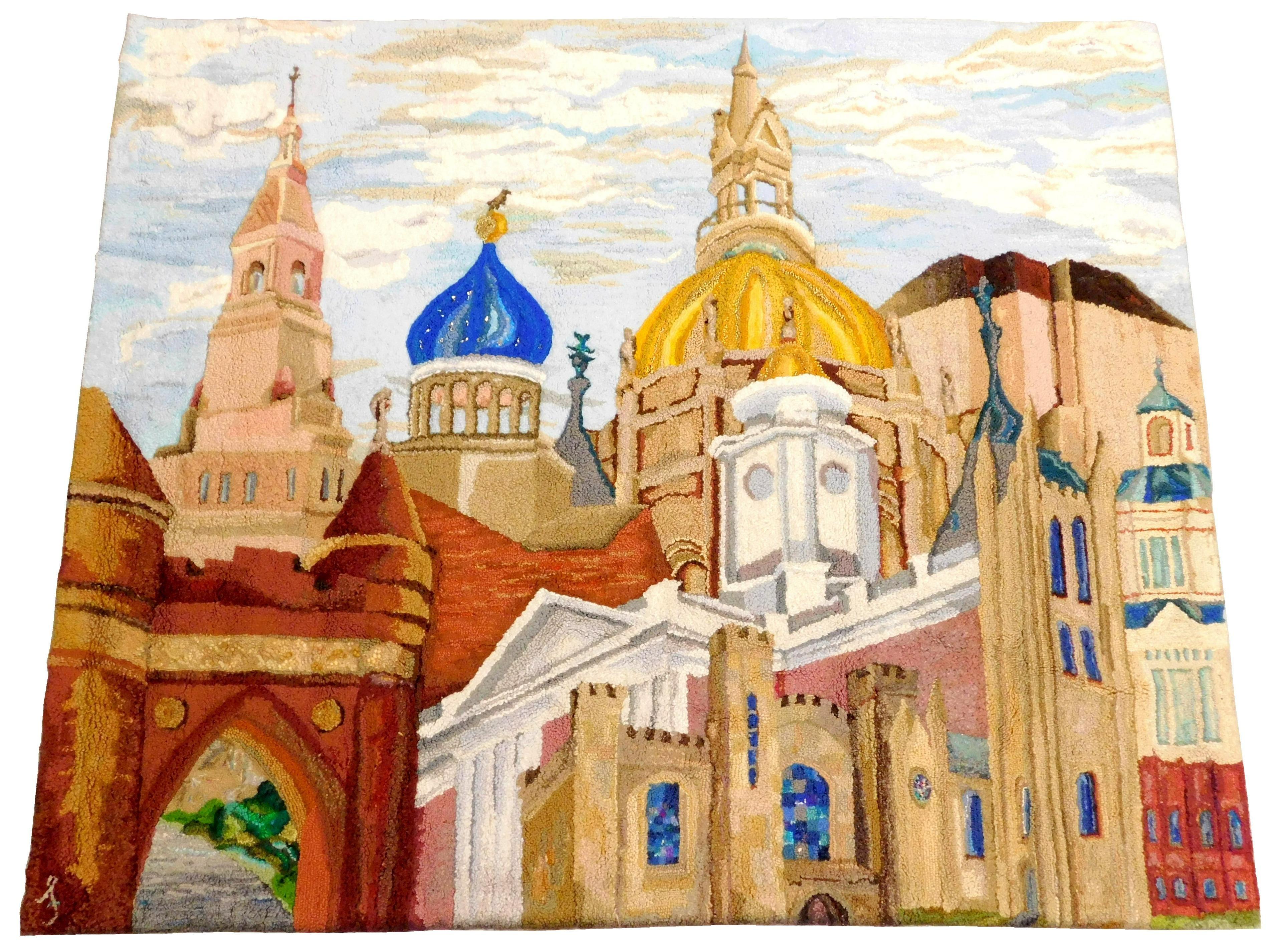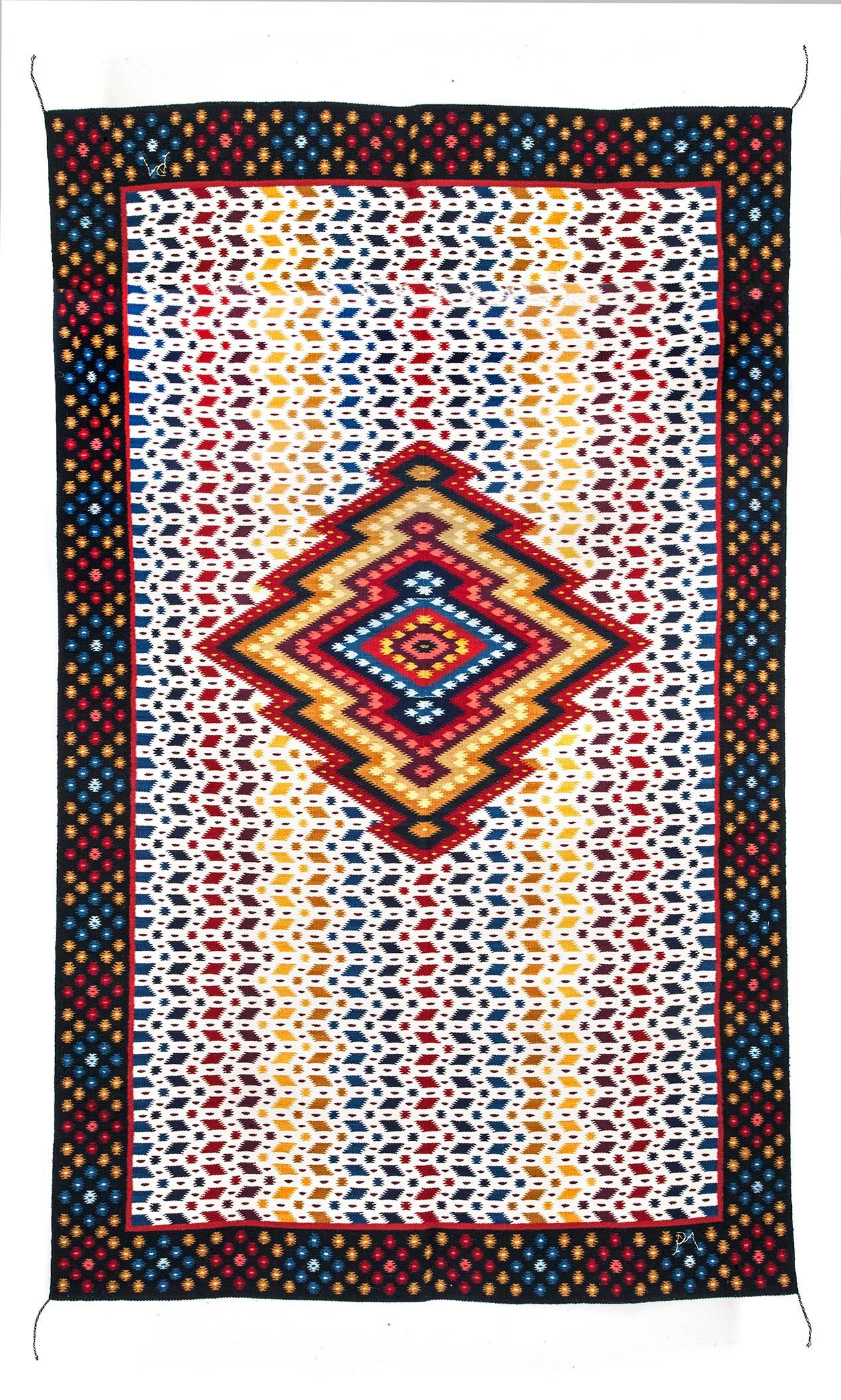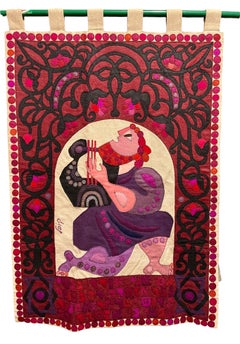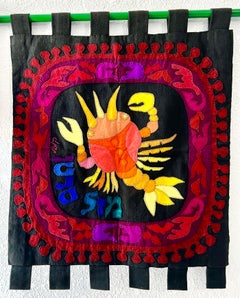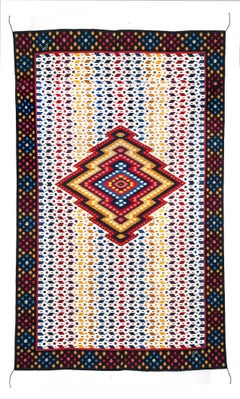
Vintage Handwoven Tapestry Wool Folk Art Rug Weaving Pillow or Wall Hanging
View Similar Items
Olga FischVintage Handwoven Tapestry Wool Folk Art Rug Weaving Pillow or Wall Hanging c.1950s
c.1950s
About the Item
- Creator:Olga Fisch (1901 - 1990, Ecuadorian, Hungarian)
- Creation Year:c.1950s
- Dimensions:Height: 16 in (40.64 cm)Width: 19.5 in (49.53 cm)Depth: 4 in (10.16 cm)
- Medium:
- Movement & Style:
- Period:
- Condition:good. minor wear commensurate with age.
- Gallery Location:Surfside, FL
- Reference Number:1stDibs: LU3824031862
Olga Fisch
Despite her Hungarian roots, artist Olga Fisch is remembered as the “mother of Ecuadorian folk art” due to her love of Ecuador’s art and culture. Best known for her vibrant rug designs and tapestries, Fisch contributed greatly to promoting Ecuadorian folk art abroad and introducing the country’s traditions and heritage to the world.
Born in Budapest in 1901, Fisch became interested in art at an early age. In her youth, she collected Hungarian folk crafts and was keen on becoming a painter.
In the 1920s, Fisch studied realist painting at an art school in Düsseldorf, Germany. There, she met her first husband, the sculptor Jupp Rübsam, and the couple moved to Vienna, Austria, where she worked as a ceramics designer. Following their divorce, Fisch grew unsettled by the burgeoning anti-Semitism in pre-World War II Germany. After she married for a second time, Fisch and her husband traveled to Morocco, Eritrea, Italy and the United States before receiving asylum status in Ecuador in 1939.
Settling in Quito, Fisch became enamored with traditional Ecuadorian folk art and returned to her childhood hobby of collecting crafts — everything from pottery and hand-carved wood sculptures to colorful textiles. Fisch’s sizable collection prompted her to open a gallery, called Folklore, in 1942. However, what she considered beautiful art was regarded by others as crude.
“When I first started collecting the local Indian art and then opened this gallery, people were shocked,” she said in an interview with The Christian Science Monitor. “I remember someone asking, ‘How can you, as a cultured European woman, collect this trash?’” Nevertheless, Fisch’s collection soon garnered international attention and acclaim.
In the 1940s, Fisch began designing folk art-inspired rugs, hand-woven by indigenous Ecuadorian weavers. One rug caught the eye of acclaimed writer Lincoln Kirstein, then curator of New York’s Museum of Modern Art; he commissioned her to create a rug for the museum’s collection. Over the years, Fisch also made rugs for the United Nations Headquarters and the Metropolitan Opera.
Fisch returned to Hungary in 1987 to visit family members who had survived the Nazi regime. She later came back to Quito, where she died in 1990.
Today, Fisch’s legacy lives on through the Olga Fisch Folklore brand, store and museum, which still operates in Quito. Her works are in the collections of the Museum of Modern Art in New York and the Textile Museum in Washington, DC.
On 1stDibs, discover a range of vintage Olga Fisch rugs and other art.
- Wool Felt Craft Applique Vintage Israeli Judaica Folk Art Tapestry Kopel GurwinBy Kopel GurwinLocated in Surfside, FLThis depicts King David playing the harp, along with a verse in Hebrew from the Psalms. all made by hand. woven and stitched. Vintage, original piece. Kopel Gurwin (Hebrew: קופל גורבין) (1923–1990) was an Israeli tapestry wall hanging, painter and graphic artist. Kopel (Kopke') Gurwin (Gurwitz) was born and raised in Vilna, the capital of Lithuania. He spoke Yiddish at home, but simultaneously studied Hebrew at their school which was part of the Tarbut educational network. Kopel was active in the Hashomer Hatzair youth movement. In the 1930s, as a teenager, Kopel helped his parents with the home finances by working in a suit workshop, there he first encountered the art of sewing. With the outbreak of the Second World War and the German invasion of Vilna, the Jews were imprisoned in camps and ghettos. Kopel and his brother Moshe were separated from their parents and were put to work in coal mines and peat. Kopel's parents were taken to the Stutthof Nazi concentration camp where they died of typhus within a month of each other. Kopel's 12-year-old sister Chava was turned over to the Germans by a Polish family and murdered. The brothers were arrested by the Germans, but were saved thanks to the connections of Nina Gerstein, Kopel's drama teacher. They hid in an attic until they were discovered, fled and moved to Riga, where they were caught and sent to the Stutthof concentration camp where they were imprisoned until the end of the war. They were put to work maintaining and cleaning trains and took part in one of the death marches. In July 1946, Kopel and Moshe sailed to Helsingborg, Sweden, as part of operation "Folke Bernadotte", in which Sweden took in ill survivors for rehabilitation. Once he recovered, Kopel worked in a publishing house and later was appointed director of the local branch of the Halutz movement. In 1950 Kopel and Moshe made aliyah to Israel. Kopel worked as a survey for the Survey of Israel Company. In 1951, he enlisted to the Communication Corps and served as a military draftsman. There he won first prize for the design of the front cover of the Communication Corps bulletin. With his discharge from the army at 29 he started studying drawing and graphics at the Bezalel Academy of Arts and Design in Jerusalem. Among his teachers were Isidor Ascheim, Shlomo Vitkin, Yossi Stern and Jacob Steinhardt. At the end of his first year of study, Kopel won the Reuben and Sarah Lif Excellence Award in written studies. During his studies he also won additional prizes: In 1956 he won first prize from the Lethem Foundation in California for poster design. Later the same year, Kopel won the Hermann Struck prize for his drawing on the theme of Jerusalem. In 1957 he won an additional first prize from the Lethem Foundation and second place from the printing company Ortzel for a drawing for a Jewish New Year greeting card. In 1958 he won first prize in a competition to design a poster for Tel Aviv's jubilee. Two years later he won three other awards: First and third prize for designing a poster for Israel Independence Day, celebrating 12 years of the State of Israel. Also that year Kopel won first prize for a poster to mark the 25th Zionist Congress. In 1964 he entered the Independence Day poster competition on the theme of aliyah and won first and second prize. Four years later he again entered the competition on the theme of 20 years of Israel's independence and won first prize. The poster was styled like a Holy Ark curtain with two lions and a menorah at its centre. This poster appeared on the cover of the famous book Jewish Art and Civilization, edited by Geoffrey Wigoder as well as the record Voices of 20 Years, 1948-1968, edited by Yossi Godard. In April 1971 he won first prize in the Independence Day poster competition for the fourth time. Kopel's Folk Art tapestry won the Israeli Independence Day Poster Contest in 1968 With the completion of his studies at Bezalel Kopel moved to Tel Aviv and was hired by Shmuel Grundman's graphics and design studio. Grundman took him to Europe with him to design and supervise the construction of Israeli exhibition pavilions. During his time at Grundman's he discovered the fibrous felt from which he produced most of his wall hangings. At the 1964 Levant Fair exhibition he used felt stuck onto wooden panels for the first time. The first felt wall hanging that Kopel produced was intended for the American Cultural Centre in Jerusalem and its theme was the United States Declaration of Independence. The wall hanging, which measured 2.85 X 1.85 meters, was stuck on a wooden panel. Kopel ordered rolls of felt from France and began work on wall hangings based on bible stories. He used a needle, hand sewing small even stitches with black embroidery thread which framed and highlighted every detail in the work, as well as using appliqué. The interior designer, Alufa Koljer-Elem, introduced him to Ruth Dayan who managed the shop Maskit in September 1967 he opened his first solo exhibition at the Maskit 6 gallery, in which 12 wall hangings were displayed. In light of the exhibition at Maskit 6, Meira Gera, the director of artistic activity at the America-Israel Cultural Foundation, organized an additional exhibition of his works at the foundation's exhibition hall in New York City. The exhibition sparked immense press interest, and was also displayed for a few months at the New York Jewish Museum, from where it travelled throughout the United States. Followed by the exhibition at the Delson-Richter gallery in Old Jaffa, which was later also exhibited at the Jerusalem Theatre. Kopel's tapestry "The Time for Singing has Arrived" was printed on a UNICEF greeting card in 1978 and again in 1981. The Israeli Philatelic Service issued three stamps based on three of Kopel's holy ark curtains and one stamp based on an Independence Day poster he designed. Kopel's creations decorate a large number of synagogues, public buildings, hotels and private collections which were purchased in Israel and around the world. They have decorated, among others, the walls of the King David Hotel...Category
20th Century Folk Art Mixed Media
MaterialsWool, Felt
- Wool Felt Applique Israeli Folk Art Signed Tapestry Kopel Gurwin Bezalel SchoolBy Kopel GurwinLocated in Surfside, FLThis depicts a Crab, In Hebrew Mazel Sartan (the Zodiac symbol Cancer, June-July) all made by hand. woven and stitched. Kopel Gurwin (Hebrew: קופל גורבין) (1923–1990) was an Israeli tapestry wall hanging, painter and graphic artist. Kopel (Kopke') Gurwin (Gurwitz) was born and raised in Vilna, the capital of Lithuania. He spoke Yiddish at home, but simultaneously studied Hebrew at their school which was part of the Tarbut educational network. Kopel was active in the Hashomer Hatzair youth movement. In the 1930s, as a teenager, Kopel helped his parents with the home finances by working in a suit workshop, there he first encountered the art of sewing. With the outbreak of the Second World War and the German invasion of Vilna, the Jews were imprisoned in camps and ghettos. Kopel and his brother Moshe were separated from their parents and were put to work in coal mines and peat. Kopel's parents were taken to the Stutthof Nazi concentration camp where they died of typhus within a month of each other. Kopel's 12-year-old sister Chava was turned over to the Germans by a Polish family and murdered. The brothers were arrested by the Germans, but were saved thanks to the connections of Nina Gerstein, Kopel's drama teacher. They hid in an attic until they were discovered, fled and moved to Riga, where they were caught and sent to the Stutthof concentration camp where they were imprisoned until the end of the war. They were put to work maintaining and cleaning trains and took part in one of the death marches. In July 1946, Kopel and Moshe sailed to Helsingborg, Sweden, as part of operation "Folke Bernadotte", in which Sweden took in ill survivors for rehabilitation. Once he recovered, Kopel worked in a publishing house and later was appointed director of the local branch of the Halutz movement. In 1950 Kopel and Moshe made aliyah to Israel. Kopel worked as a survey for the Survey of Israel Company. In 1951, he enlisted to the Communication Corps and served as a military draftsman. There he won first prize for the design of the front cover of the Communication Corps bulletin. With his discharge from the army at 29 he started studying drawing and graphics at the Bezalel Academy of Arts and Design in Jerusalem. Among his teachers were Isidor Ascheim, Shlomo Vitkin, Yossi Stern and Jacob Steinhardt. At the end of his first year of study, Kopel won the Reuben and Sarah Lif Excellence Award in written studies. During his studies he also won additional prizes: In 1956 he won first prize from the Lethem Foundation in California for poster design. Later the same year, Kopel won the Hermann Struck prize for his drawing on the theme of Jerusalem. In 1957 he won an additional first prize from the Lethem Foundation and second place from the printing company Ortzel for a drawing for a Jewish New Year greeting card. In 1958 he won first prize in a competition to design a poster for Tel Aviv's jubilee. Two years later he won three other awards: First and third prize for designing a poster for Israel Independence Day, celebrating 12 years of the State of Israel. Also that year Kopel won first prize for a poster to mark the 25th Zionist Congress. In 1964 he entered the Independence Day poster competition on the theme of aliyah and won first and second prize. Four years later he again entered the competition on the theme of 20 years of Israel's independence and won first prize. The poster was styled like a Holy Ark curtain with two lions and a menorah at its centre. This poster appeared on the cover of the famous book Jewish Art and Civilization, edited by Geoffrey Wigoder as well as the record Voices of 20 Years, 1948-1968, edited by Yossi Godard. In April 1971 he won first prize in the Independence Day poster competition for the fourth time. Kopel's Folk Art tapestry won the Israeli Independence Day Poster Contest in 1968 With the completion of his studies at Bezalel Kopel moved to Tel Aviv and was hired by Shmuel Grundman's graphics and design studio. Grundman took him to Europe with him to design and supervise the construction of Israeli exhibition pavilions. During his time at Grundman's he discovered the fibrous felt from which he produced most of his wall hangings. At the 1964 Levant Fair exhibition he used felt stuck onto wooden panels for the first time. The first felt wall hanging that Kopel produced was intended for the American Cultural Centre in Jerusalem and its theme was the United States Declaration of Independence. The wall hanging, which measured 2.85 X 1.85 meters, was stuck on a wooden panel. Kopel ordered rolls of felt from France and began work on wall hangings based on bible stories. He used a needle, hand sewing small even stitches with black embroidery thread which framed and highlighted every detail in the work, as well as using appliqué. The interior designer, Alufa Koljer-Elem, introduced him to Ruth Dayan who managed the shop Maskit in September 1967 he opened his first solo exhibition at the Maskit 6 gallery, in which 12 wall hangings were displayed. In light of the exhibition at Maskit 6, Meira Gera, the director of artistic activity at the America-Israel Cultural Foundation, organized an additional exhibition of his works at the foundation's exhibition hall in New York City. The exhibition sparked immense press interest, and was also displayed for a few months at the New York Jewish Museum, from where it travelled throughout the United States. Followed by the exhibition at the Delson-Richter gallery in Old Jaffa, which was later also exhibited at the Jerusalem Theatre. Kopel's tapestry "The Time for Singing has Arrived" was printed on a UNICEF greeting card in 1978 and again in 1981. The Israeli Philatelic Service issued three stamps based on three of Kopel's holy ark curtains and one stamp based on an Independence Day poster he designed. Kopel's creations decorate a large number of synagogues, public buildings, hotels and private collections which were purchased in Israel and around the world. They have decorated, among others, the walls of the King David...Category
20th Century Folk Art Mixed Media
MaterialsWool, Felt
- Vintage Handwoven Tapestry Wool Folk Art Rug Weaving Wall Hanging Olga FischBy Olga FischLocated in Surfside, FLOlga Fisch ( American 1901-1990) Hummingbird and Pendant Flower, hand woven and stitched wool and sequins, signed lower right. Dimensions: 58 x 32 in. Olga Fisch was born in Hungary, studied in Germany and lived in Morocco and Ethiopia before receiving asylum as a Jewish refugee in Ecuador in 1939. For her Indian-inspired designs, Mrs. Fisch uses natural black and white sheep...Category
20th Century Folk Art More Art
MaterialsWool
- Vintage Handwoven Tapestry Wool, Metal Folk Art Rug Weaving Wall HangingBy Olga FischLocated in Surfside, FLOlga Fisch was born in Hungary, studied in Germany and lived in Morocco and Ethiopia before receiving asylum as a Jewish refugee in Ecuador in 1939. For her Indian-inspired designs, Mrs. Fisch uses natural black and white sheep...Category
1950s Folk Art More Art
MaterialsWool
- Vintage Handwoven Tapestry Wool Folk Art Rug Weaving Pillow or Wall HangingBy Olga FischLocated in Surfside, FLOlga Fisch was born in Hungary, studied in Germany and lived in Morocco and Ethiopia before receiving asylum as a Jewish refugee in Ecuador in 1939. For her Indian-inspired designs, Mrs. Fisch uses natural black and white sheep...Category
1950s Folk Art More Art
MaterialsWool
- Vintage Handwoven Tapestry Wool Folk Art Rug Weaving Pillow or Wall HangingBy Olga FischLocated in Surfside, FLOlga Fisch was born in Hungary, studied in Germany and lived in Morocco and Ethiopia before receiving asylum as a Jewish refugee in Ecuador in 1939. For her Indian-inspired designs, Mrs. Fisch uses natural black and white sheep...Category
1950s Folk Art More Art
MaterialsWool
- "Kilim Rug (Red & Black), " Hand Woven Mid 20th Century under $4500 designLocated in Milwaukee, WIThis Kilim rug was hand woven in Turkey, circa mid-20th century from wool. It features geometric patterning in red, black, blue, and yellow and is priced under $4500. The design is perfect with any décor as it completes both contemporary and antique interior design settings. As part of the Design Lovers...Category
Mid-20th Century Folk Art More Art
MaterialsWool, Textile, Organic Material
- Diamante / Textiles Mexican Folk Art RugBy Pedro Mendoza GutierrezLocated in Jesus del Monte, MXFREE SHIPPING TO WORLDWIDE! Artisan: Pedro Mendoza Gutierrez MASTERPIECE Rug made in treadle loom with Wool threads dyeing with natural tints: huizache, cochineal, indigo, pericon...Category
2010s Folk Art More Art
MaterialsWool, Cotton
$3,000 Sale Price40% OffFree Shipping - El Sol / Textiles Mexican Folk Art RugBy Pedro Mendoza GutierrezLocated in Jesus del Monte, MXFREE SHIPPING TO WORLDWIDE! Artisan: Pedro Mendoza Gutierrez MAIN MASTERPIECE EXPOSITION "MANOS Y ALMA DE OAXACA” Mexico City 2016 Rug made in treadle loom with Wool threads dyein...Category
2010s Folk Art More Art
MaterialsWool, Cotton
$3,300 Sale Price40% OffFree Shipping - Kilim Rug Hand-woven design, under $4500Located in Milwaukee, WIThis Kilim rug was hand woven in Turkey, circa mid-20th century. It features patterns in yellow, gray, white, brown, and pink in a beautiful geometric design. Priced under $4500, this rug is sure to be enjoyed with several design schemes as it works in both modern and antique settings. Lovers of carpets will appreciate the wool under their feet as they keep their interior both stylish and comfortable. Kilim rugs are a pileless rug woven using just one of numerous flat weaving techniques that originated in parts of Turkey. Other geographical areas producing kilim style rug weaving include Iran, North Africa, Afghanistan, Pakistan, China, the Balkans, Central Asia, and the Caucasus. Perfect for the design lovers sale...Category
Mid-20th Century Folk Art More Art
MaterialsWool, Textile, Organic Material
- British Woolie in Maple FrameLocated in Austin, TX"Sailboat in a Maple Frame" - British Woolie, 1870 Wool Embroidery 12 x 19.5 inches Framed 14 x 22 inches 19th Century British Woolie in Maple Frame fe...Category
Late 19th Century Folk Art More Art
MaterialsWool
- 19th Century British Steamboat WoolieLocated in Austin, TX19th British Steamboat with lighthouse featuring English St. George Flag at the Bow and Stern of the ship and a Union Jack Flag at the Stern of the ship. Frame is Birds Eye MapleCategory
Mid-19th Century Folk Art More Art
MaterialsWool
